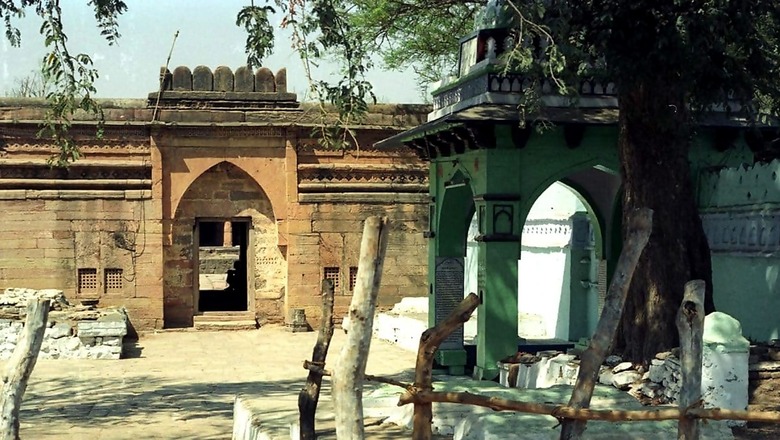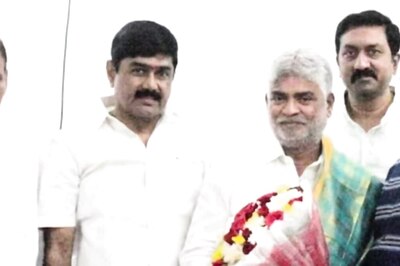
views
Brazenness often backfires. Invading Islamic rulers intent on stamping their authority on an infidel land—India—decided that temple spolia would make a great statement of domination. So, starting with the Quwwat-ul-Islam mosque in New Delhi’s Mehrauli area in 1193, successive Islamic dynasties fashioned mosques, mazhars and madrassas using pillars and other distinctive masonry elements of Hindu and Jain temples that they desecrated and destroyed.
That aggrandising policy is coming back to haunt the present with the Supreme Court also refusing to stay the Madhya Pradesh High Court-ordered “scientific examination” of the Bhojshala in Dhar by the Archaeological Survey of India to ascertain its origins. Though Ayodhya, Kashi and Mathura are the lightning rods for anger over temples supplanted by mosques, the uncomfortable truth is that they are not the only places where this happened in medieval India.
While the stance of the apex and high court has caused consternation in the usual circles, clarity on the issue should be welcomed. After all, the medieval era Bhojshala—the site’s original name and purpose are still shrouded in mystery—is a Monument of National Importance, protected and managed by the ASI, and the people of India certainly should know why it is categorised as such. Glossing over the truth does not bode well in the long run as we all know.
The fact that thanks to an ASI order in 2003, puja has been allowed inside the complex on Tuesdays and namaz on Fridays—plus Saraswati Puja on Basant Panchami—harks back to a tussle that portends to become a full-fledged battle eventually. More so as the ASI apparently passed and implemented the puja-namaz order without ascertaining the actual antecedents of the complex, and therefore the respective rights of both communities to worship there.
A certain kind of Indians may wonder why a place that sounds like a restaurant (“Bhoj” also means food and “shala” means place, after all) is a flashpoint. They are not deracinated cretins, it is just that many important personages have been glossed over by school history books that are the first (and usually only) point of contact most Indians have with the past. Apart from such omissions, it is routinely taught so badly in school that many Indians get bored or end up concluding that our history is just a litany of regressive practices that are best forgotten.
So it would not be surprising if, even months after the Bhojshala dispute hitting the headlines, many Indians still have no idea that Maharaja Bhoja was a legendary—not mythical—11th-century Parmara ruler of Malwa, a wartime ally of the great Rajendra Chola. He was a polyglot and a polymath with 84 books to his credit on subjects ranging from astronomy to architecture, poetry to chemistry, and had a worthy battle record too. In short, a renaissance man.
Internalising this fact about the Parmara ruler is central to understanding why the Bhojshala dispute is resonating 900 years later. Maharaja Bhoja’s kingdom and its capital, Dhar, were the centre of culture in central India, and expectedly, he built many temples as he grew in power and stature. Ironically, those very temples were most certainly the source of the hundreds of stone “spolia” brazenly used in the mosque-dargah complex later dubbed as the Bhojshala.
Some question the spolia’s origin, but the Udaipur Prashasti says Bhoja “covered the earth with temples” and the Jain monk Merutunga says in Prabandha-Chintamani that he built 104 temples in Dhar alone. Today, Bhojpur temple is the only intact shrine of that period. So did the Islamic conquerors commission carved stones in varying sizes and designs because they were bored? Or was the mosque an early example of recycle and reuse eco-friendliness?
Those who question should be despatched to Vidisha, 300km away, to have a look at Vijayamandal, now known as Bija Mandal, ironically, not far from the famous Heliodorus Pillar. Ironic because the many-pillared 11th century Bija Mandal has disappeared, but its gigantic plinth remains. And on top of it now sits a sealed, rather badly built 17th-century mosque whose edifice includes pillars that could only have come from… a temple. The message rings clear even now.
The vanished Bija Mandal’s once-soaring magnificence can be easily imagined from the many stone pillars, statuary, decorative carvings and other architectural elements that lie stacked neatly all around like a warehouse. These and the empty plinth are solid proof of the fate of many temples, including those whose spolia have been used in Bhojshala. Its destruction and repurposing into Islamic structures is clear; but what about Bhojshala’s more recent history?
According to documents submitted by the state government and cited in the HC order, revenue records till 1935-1936 described the premises as “Bhojshala & Temple” under survey number 313 old (604 new) of village Dhar. There was no mention of a masjid. Since the “Bhojshala” was notified as a protected monument under the Monuments Act, 1904 and again in 1958, it was managed by the ASI and owned by the state, and therefore could not be waqf property either.
Crucially, the documents show that the dargah of Hazrat Kamaluddin Chishti (Kamal Maula) is on survey number 302, not in 313 like the Bhojshala. Moreover. there was no evidence of namaz being offered there before 1935. So, the MP Government contended that the 1935 order issued by the Dewan of the princely state of Dhar to allow a day of namaz and dua there (for the then ruler’s health) was illegal as the premises was already under ASI control since 1905.
So why and how did the former temple complex now called Bhojshala become ‘Kamal Maula’ mosque and dargah? History has the answer. Central India came onto the radar of the Islamic Sufi preachers of the northern part of the subcontinent from the 12th century. And from the 13th century onwards, members of the Chishti order were despatched from Delhi, to settle down in the Hindu centres of central India—Ujjain, Dhar, Mandu, Chanderi etc—to ‘spread the word’.
One of them was Kamaluddin, a disciple of Nizamuddin Auliya, who arrived in Dhar at the end of the 13th century—over two centuries after Bhoja’s death—and passed away there in 1331. It was during Kamaluddin’s central Indian mission that a huge army of the then Sultan of Delhi Alauddin Khilji (as chronicled by Amir Khusro) led by his general Ayn-ul-Mulk Multani, conquered Malwa and killed the Parmara ruler Mahakaladeva who had fled to Mandu.
Significantly, Multani also broke the magnificent iron pillar at Dhar into three pieces, which now lie horizontally on separate stands. This iron pillar has the same properties as the famous one in Delhi, and was probably erected by Bhoja, as Malwa was a centre of metallurgy in his time. Unfortunately, there are no inscriptions indicating its provenance but the adjacent “Lat (pillar) Ki Masjid” also made in 1405 mostly with temple spolia points as a probable cause.
It cannot be a coincidence—or an example of secular, eco-friendly recycling—then that an older hypostyle (multi-pillared and flat-roofed) mosque was built at what is now called Bhojshala in Dhar too, using spolia from destroyed temples. An inscription indicates the mosque was built there around 1310–1320. And when the Sufi missionary Kamaluddin passed away in 1331, his tomb and dargah were constructed alongside, leading to the name Kamal Maula Masjid.
One angle of the current dispute relates to whether there was a temple of Saraswati (Vagdevi) at the site of the Bhojshala complex. A statue of a devi now in a museum in the UK is said to be of the presiding deity, but there is no definitive proof. However, the plethora of inscriptions on reused temple remnants are reason enough to conclude a non-Muslim place (or places) of worship existed where the current complex now stands. No survey in 2024 can contradict that.
As with the disputes in Kashi, Mathura and Ayodhya, besides Bhojshala and countless other spots including Bija Mandal, it boils down to squarely admitting what happened. Repudiation is futile because when those acts were perpetrated, the deliberate use of spolia ensured that there was no loophole left for plausible denial in later centuries. Only honest acknowledgement can assuage the hurt of centuries and lead to mutually acceptable peaceful solutions.
The author is a freelance writer. Views expressed in the above piece are personal and solely those of the author. They do not necessarily reflect News18’s views.


















Comments
0 comment